By LuLing Osofsky, April 2017
As part of its Extraction events series, which explores the implications and consequences of extractive industries, the Center of Creative Ecologies invited Matt Coolidge, Founder and Director of the Center for Land Use Interpretation (CLUI), to speak with CCE member LuLing Osofsky about some of CLUI’s projects that look at mining and subterranean land use. A research and education organization, CLUI is “dedicated to the increase and diffusion of knowledge about how the nation’s lands are apportioned, utilized and perceived.” This interview follows up on Matt’s talk at UCSC, and continues the conversation on how extraction fits into CLUI’s conceptual, aesthetic and political framework.
LuLing Osofsky: Can you describe the impetus behind “Pits and Piles” as one of CLUI’s interpretive schema? The visibility of carving out and piling atop is sublime; it completely dwarfs us. As a viewer, in grappling with the magnitude conveyed in these images, I’m curious about your gravitation towards extractive sites. In your recent talk at UC Santa Cruz for the Extraction project during Winter 2017, where you gave a lecture entitled “Pits and Piles,” you made an intriguing comment about how certain piles are deposited in a pyramid-like formation, evoking something of an ancient site of reverence. Can you talk a bit more about the power of pits and piles?
Matthew Coolidge: Pits and Piles is literal, allegorical, and central to everything. Start with a flat place, anywhere. Then grab a shovel, and stick it in the ground. Pull out a load of dirt, and you have a pit. Pivot the shovel to the side and turn it over, and you have a pile. That’s what life is about. You cannot have one without the other, and you cannot have life without making pits and piles. Birds do it. Bees do it. We do it. Everything comes from somewhere, and goes somewhere. If not, you have stasis, which is the opposite of life.
Piles are generally what we make by intent, what we are interested in, what drives the economy, what we want, our monuments. Pits are usually incidental, the things created in order to make something else, a byproduct. Take Manhattan. The most concentrated accumulation of wealth and culture in the country, and a great big pile of architecture. All of it came from somewhere else, from millions and millions of big and little pits all over the place. In order to understand and evaluate Manhattan, you have to include these pits as part of its structure. I think it was the writer Gray Brechin who called skyscrapers “inverted minescapes.” Indeed. It also relates to the people and activity there, which draws from other places too. For every yin, there is a yang. Up/down, in/out, womb/tomb, etc./etc.
LO: Do you think extraction plays a unique role in the way we think about our nation, the stories we learn or perpetuate about American history? I’m thinking of your comment about CLUI’s mission being, in some ways, like the Smithsonian’s— Telling America’s Stories. Does CLUI’s interest in, or approaches to, certain extraction sites reflect, probe or push back against any of these narratives?
MC: Often these sites of extraction, these literal and metaphoric pits, these sources, are the other side of history, the quotidian, the overlooked, the covered up. They are the groundtruths, and the underground. We know we should keep them in mind, but we often don’t, because they are ugly, utilitarian, boring, uncertain, inconvenient, or dark, like a bad conscience we are trying to avoid experiencing. They are the backstory, not the main story, the herstory to history. “Chinatown.”
Or they can be. Probably just as often they are the wonderful discoveries, the affirmation of our assumptions, the full accounting where the numbers finally add up. Should we point at a big open pit copper mine as the most ugly thing, a desecration of the land? Or is it the most beautiful thing on earth because it is an honest, epic depiction of the extent of human endeavor, one where there is no lie in the land – the lie is the one we make to ourselves, that we deny that we all made that pit, collectively, to wire and plumb our country, and that we enjoy all that copper everyday. Those skyscrapers in New York hide all their wiring and plumbing, because it is utilitarian and boring or whatever. That is the ugly thing, that denial, that hypocrisy. The pit is truth. That is where we should stage the opera, and hang the art. One could argue.
LO: In acknowledging the inherent subjectivity of a photograph, you describe CLUI’s approach to photography— ideally the photograph is “neither good nor bad”—its job is to transmit content, not exist as art. Does this translate into your curatorial approach as well? In creating a show, do you try to emulate that sense of conveyance as transparently as possible? Would you consider your wall text reportage? Or do you take more liberties curatorially in shaping an interpretive experience for a viewer?
MC: Just to be clear, these are not universal statements about photography, they relate to the Center’s ideas and uses for the medium. To us here at the CLUI, photography is a tool, a means to an end, a medium for the message. If a photo is too good, then it is about the photographer’s skills, and the photographer, which can be interesting, but it changes the topic. If the photo is too bad, like a blurry photo out the window of a car, then it is about the medium too. If the photo is too good, or too bad, then instead of being a photograph describing and depicting something, it is a photograph about photography. As a window, it becomes opaque. We generally use photography, text, and context, to describe places. We use these mediums because they are affordable, conventional, and effective. But they are limited too, and subjective, but we try to minimize that, with clarity and simplicity. We try to use these mediums as frames to show things. It is in the selection of things we show that the story is largely being told.
And part of that clarity is acknowledging the precedents and history of these mediums, showing that you are aware of them, in order to further assert the validity of the claim to the frame. A photo is most useful to us when it is invisible, while making what it contains visible. One of the limitations of photos are that they are only moments in time, which is not how we experience the world. We use video a lot too, usually from fixed camera positions, and no edits, just a gaze at a place. Like a kinetic photo, more like looking through a window. Given the volume of places we depict in our exhibitions, we simply do not have the time to make these videos of everyplace, so we take photos, mostly. We use videos especially when the subject of the exhibit is about time, in some way. Like waiting for something. Or about motion and flow, like streets, or waterfalls.
Whether or not any or all of this is art is another question altogether, and one that I will avoid, as it’s up to you, the viewer, the audience, to decide. If you even need to bother to. I am not sure it matters. What is art? How about: Art is the experience of truth that resonates in ways that can only be effectively conveyed through yet more art.
Art can be anything, if it is framed as such. It can be a thing that you point at and say “that is art.” (Whether it is “good art” or not is another question). Marcel Duchamp spelled this out a century ago. Art is constructed on the receiving end, not the transmitting end. The viewer assembles art in their mind from the raw material they collect from outside their mind. Also, I would suggest, that you do not even need to be aware that you are experiencing art in order to experience art. It can happen through other means, and does everyday, hopefully. I am sorry for those who don’t allow this to happen to them. Most people I guess have to go to an authorized art purveyor to experience art. Those big neoclassical steps and ionic columns and expansive white walls are convincing contexts that validate their contents as precious valuable certifiable art. But that cruddy little chewing gum wrapper on the sidewalk outside can be art too, and just as powerful. It’s all about context, and it’s up to you.
LO: You’ve mentioned that everything is ecological, as everything is part of a relational system. For me this raises questions about the limits of a medium like photography— how can we look beyond the static, fragmented quality of a photograph towards an interpretation of relationality, of duration, causation? Can photography show relationality? Along these lines, it’s fascinating to conduct searches in the CLUI database, where there is generally one image used in representing each site. There’s an aesthetic of digestible simplicity in having one image per entry. Once you have multiple points of view for a place, the interpretive framework changes, perhaps a narrative emerges. Is representative consistency a concern? What’s the thinking behind the lone image? How do you choose which image to use? The database is so comprehensive, yet leaves the sense there’s an infinitude of possible entries. There’s a brief description/bio for each site, helping situate it physically and historically. The descriptive language is very neutral. In considering the consequences of certain extractive procedures, is CLUI’s aim to document the visibility and legibility of that site as a neutral artifact, extracted, in a sense, from its role in a broader narrative that involves complex social and environmental repercussions?
MC: Lots of questions in this question. Rather than try to have multiple answers, maybe I’ll say this: Robert Smithson said there was a dialectic between sites (places) and non-sites (representation of places). Now perhaps there is a trialectic of site, non-site and website. The multidimensional space of the web, linking scalable maps, multiple images, perspectives, and linkages to the world of information around the site, is a third kind of space. Immaterial infospace. While this is not three dimensional, it is a third way of experiencing a place. And this relationship between these three types of spaces is part of the Center’s institutional DNA, from the beginning. We started with collecting lat/longs, locatable sites, represented by their coordinates. Physical sites. Put in a database. We document them and describe them in exhibits. Nonsites. Then we put them on the web, through a database linked with scalable maps and images (sometimes one, sometimes more), and links to other sources of information on the web. We started doing this in 1995, when the web was just beginning, and we grew up with this evolving technology. In a world of GoogleMaps and Wikipedia and such, our online database is less unique, but perhaps still useful, as it represents a curated selection of places, not an index of everything. We hope to be improving this in the future, making it more hermetic, perhaps, a kind of antiweb. We’ll see.
LO: That previous question broaches politics, so I’ll expand here: you’ve talked about CLUI’s approach as intentionally apolitical, and I can appreciate the kind of interpretive openness that allows for, and the relief a viewer might feel in absorbing images that don’t project an emphatic or even dogmatic position. Yet I think you also mentioned how maintaining neutrality is itself a politicized choice. Do you feel that such a stance in our present context feels like a particularly subversive and/or important decision? This recent election season saw many organizations that had never before endorsed nor spoken out against a candidate doing so. Have you/has CLUI felt a desire, or internal or external pressure, to shift your organization’s approach towards (re)presenting sites that people see as places of contestation? If even entertaining the idea, what would be at stake? Or do you feel that CLUI’s representational neutrality is now more politically urgent than ever, at a time when the White House intends to monitor governmental science?
MC: As you know, everything is political. The CLUI is not apolitical, it’s just that people are used to things being super overtly political, and activisty, which we are not. People are sometimes disoriented by us. That can be constructive, that sense of uncertainty, and searching for bearings. Is that radical? Maybe. Is it effective or interesting? Your call.
LO: There’s an intimacy in many of the photographs. I sense a mutual awareness between photographer and terrain. Do you ascribe agency, knowledge, or feelings to the land/landscape? Do you conceive of a land-subject as a body capable of experiencing pleasure, violence and pain? Do you think the land uses us? Interprets us?
MC: There is a thing called “topophilia”, a love of places. I think we all love places in one way or another. Some of us might just be more polygamously topophilic. I don’t think the ground itself cares about us much though, at least not in a way we can understand. But I do think it is a vivid reflection of us. All human activity plays out on, in, above, or under the ground, and therefore all of human endeavor can be explored and examined from a “land use” point of view. The landscape of the USA is a cultural product. It is an artifact filled with artifacts, that you can look at it in a macrocosmic or a microcosmic way. It is a cultural product that tells the story of its dominant species, homo americanus, a creature that has led the charge in the transformation of the entire planet into an anthropogenic entity, where not a molecule on the surface of the earth is unaffected by humans. And this is the case forevermore. We can put things “back”, but this too would be a human construction, based on a subjective interpretation. All we can do now is go forward, and do so with a better understanding of what we have done, and what we can do. Does the land interpret us? They say that when people talk to their houseplants, the plants are healthier. Not because of what is said to the plant, but the fact that they talk to it shows that they care and that plays out in other ways. So yes, in this way, the land responds to our actions.
LuLing Osofsky is a writer, documentary photographer, educator, and PhD student in the Visual Studies program at UC Santa Cruz and a member of the Center for Creative Ecologies.




